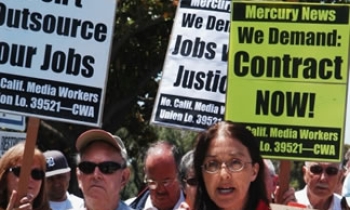NEW YORK While national news outlets from The New York Times to CNN were wrongly reporting that 12 trapped miners in West Virginia had been found alive, then later having to admit they had perished, the local Inter-Mountain newspaper of Elkins, W.Va., with the luxury of a later deadline, remained skeptical.
The 11,000-circulation afternoon daily -- based just 30 miles from the mining accident scene -- mixed lucky timing with local insight to provide an accurate report to readers Wednesday, under the headline, Nightmare In Tallmansville.
"I feel lucky that we are an afternoon paper and we have the staff that we do," said editor Linda Skidmore, who has run the 21-person newsroom for three years. "We had a reporter there all night at the scene and I was on the phone with her the whole time."
Skidmore adds that her staff never believed the miners had been found alive because no official word was ever given. She said no update about miners being found alive ever appeared on the paper's Web site, either.
"I was on the phone with her and I was hearing things on CNN and FOX that she was not hearing there," Skidmore said about reporter Becky Wagoner. "She heard that the miners were alive just before it was broadcast, around midnight. She talked about hearing church bells ringing and people yelling in jubilation--but nothing official."
Wagoner, a seven-year veteran of the paper, told E&P she had been covering the story since it broke Monday, and took a photograph at the site that was widely carried by national news outlets. She said rumors about the miners being found alive began circulating at 11:00 p.m. last night, with broadcast reports beginning at about midnight. "We heard that they were found alive through CNN, then it snowballed to ABC, then FOX and it was like a house afire," recalled Wagoner, who said she was at the media information center set up by the mine's operators, International Coal Group Inc., when the reports spread.
"A lot of the media left to go to the church where family members were located, but I stayed put because this was where every official news conference was given--and we never got anything official here," she said. "Something was not right. Then we were hearing reports that 12 ambulances had gone in [to the mine area] but only one was coming out. There was so much hype that no one considered the fact that there was no [official] update."
Wagoner said the coal company finally gave an official report at 3:00 a.m., confirming the miners had been found dead.
Skidmore and Wagoner both said they never received any official report that the governor or other officials had confirmed the miners being found alive, which some national news organizations said contributed to the errors. "I have not seen that anywhere, no video of it or any proof that the governor confirmed it," Skidmore said.
The editor noted that part of her skepticism about the miracle rescue stemmed from a history in the area of people passing on information they believe to be true with little or no sourcing. "We get a lot of people here who sometimes believe they have an inside story because they hear it on a police scanner or listen to a conversation," Skidmore said. "We know to be cautious of those situations."
Even if she had run a morning paper, Skidmore said she believes she would have held off running the story, pointing out that she did not put any of the bogus reports on the paper's Web site. She said the national press were likely victims of being outsiders and wanting to break good news.
"I think part of it is not knowing the area and seeing the families celebrating," she added. "That is sometimes enough verification for people. I would still want someone to say it is correct."









